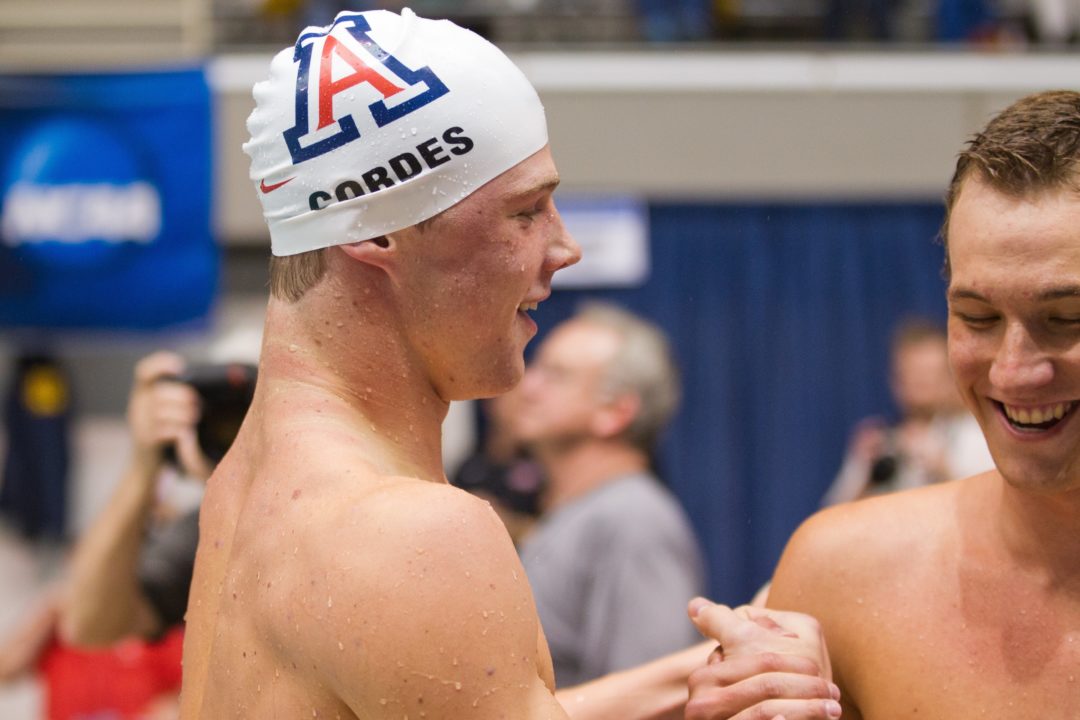The Official Psych Sheet has been released for the 2013 Men’s NCAA Division I Swimming and Diving Championship. Here are the pertinent links:
NCAA DI Men – Official Psych Sheet.
NCAA DI Men – Official Invited Swimmers by Team.
NCAA DI Men – Official List of Eligible Institutions for Relay Events.
NCAA DI Men – Official Meet Alternate List.
The cut off line was 29 swimmers per event. There was a lot of initial speculation as to what would happen with Caleb Weir and John Murray of Texas, as they were projected to be tied for the final overall spot in the 235-swimmer cap placed by the NCAA. According to the psych sheet, Weir will be swimming individuals, while Murray is currently listed as first alternate.
… And here’s a breakdown of the teams with more than 10 individual swimmers qualified.
| Team | Swimmers in Individual Events |
| Michigan | 17 |
| Cal | 16 |
| Florida | 14 |
| Stanford | 14 |
| Arizona | 13 |
| Georgia | 11 |
| Texas | 11 |
| Indiana | 10 |
| USC | 10 |

Braden can you explain how J Lyons was left out of the 1650, Did he not have any other B cuts?
He was left out by coach’s decision. They scratches him before the cut lines were even drawn.
Even though you can swim any event you have a B standard in once invited, it’s interesting to note of the teams that sent the most swimmers which ones actually had athletes who met the standard to be invited in more than one individual event.
Michigan 14/17 (five invited in 3 events)
Florida 10/14 (six invited in 3 events)
Stanford 7/14 (one invited in 3 events)
California 7/16 (two invited in 3 events)
Arizona 5/13 (none invited in 3 events)
Great analysis Josh. B standards seem to fall so easily for the top teams…kind of surprising the numbers are so low. Definitely surprised my perception.
Braden,
I assume those numbers mean how many of them were in the top 29 in multiple events, not how many of them will eventually swim 3 because of B cuts. I assume that number is much higher.
Thanks Braden. So if you’re 30th (not invited) and someone else is 29th (invited), they get as low as a 61st position swim. WUWT?
There have always been people with way lower seeds getting into the meet, just use to be on relays. At least the 29 fastest get to swim and not the 17 fastest plus a bunch who got in via a relay.
I never get why people have a problem with this. They are already there, they have proven that they are one of the top 235 performers in the country in an event. That is how we determine the top competitors for the event. Once they are in… let them swim.
How many alternates typically get in – more than 3?
It can vary so much, and with new rules probably fewer. We’ve seen two women’s alternates called in so far.
Can anyone explain how alternates work?
Fairly simple – if someone scratches from any race, whoever the next is on alternate lists gets in.
Is there a reason why it wouldn’t be the next person on the option list for that event? Wouldn’t take make more sense so that it keeps the same amount of participants in each event?
OldBear – if I had to guess, the rationale is that in an event where lets say you get through row 29 and you have 3 spots left, but 8 unique, new swimmers on that 30th row. Would you rather have the 30th 100 breaststroker, or the 31st 100 backstroker because the 100 backstroke was the event of the guy that scratched? The more pragmatic reason would be that you run into an issue of a guy scratching who is in multiple events. In a hypothetical, if Tom Shields scratches, for example. Then who gets in: the next guy in the 100 fly, the 100 back, or the 200 fly?
Braden, you know all the rules. Riddle me this, what was the tie-breaker between Caleb Weir and John Murray?
he might’ve had another cut? or had more B cuts or maybe he achieved the standard earlier in the year
The tie breaker was how close they were to the championship record in their second best event.
ok, so…if you get invited in an individual event do you get to swim your other events in which you have a b cut?
Clarify – that is correct.
Can someone explain “optional entries”? It appears the list is incomplete, there are entries that should be included but are not.
“optional entries” mean that once a swimmer is invited, either through the cut-line (this year it’s 29) or through an automatic qualifying time, they can then swim up to two other individual events for which they have met the “B” qualifying standard.
That is why you’ll see someone who was only the 35th fastest 200 breaststroker, or whatever, listed as #31 on the official psych sheets. There were swimmers in between who were never “invited” to the meet.